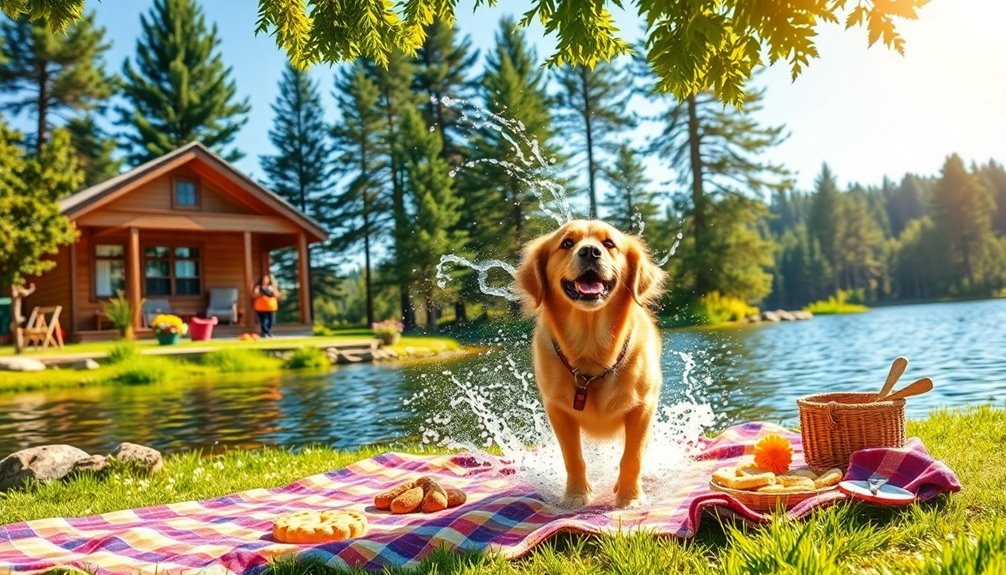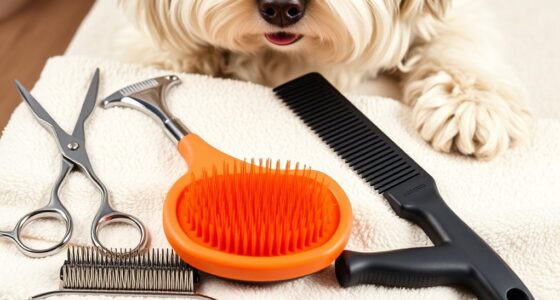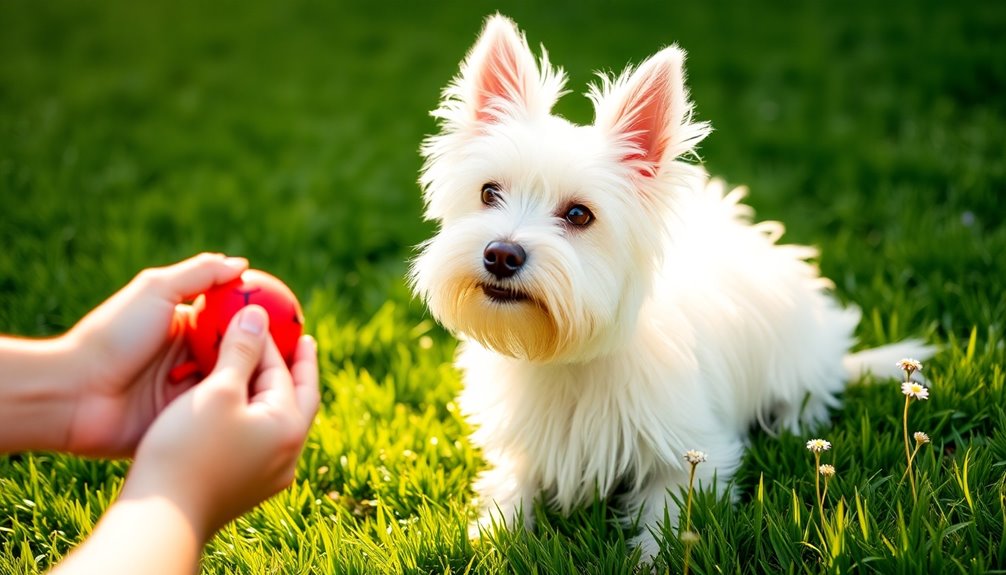Your dog needs more than just walks for a fulfilling life. While walks provide physical exercise, they lack the mental stimulation essential for your dog's emotional well-being. Boredom can lead to hyperactivity, destructive behavior, and anxiety. Engaging activities like interactive play, puzzle toys, and dog sports can enhance cognitive skills and burn off excess energy. Regular socialization through playdates or doggy daycare also boosts confidence and reduces fearfulness. To support your furry friend, mix up their routine with various activities. Stick around to discover more ideas that will keep your dog happy and healthy.
Key Takeaways
- Daily walks provide physical exercise but often lack the necessary mental engagement that dogs require to thrive.
- Engaging activities like interactive play and puzzle toys promote cognitive development and prevent boredom, essential for emotional well-being.
- Socialization through playdates and diverse environments builds confidence and reduces anxiety in dogs, enhancing their overall behavior.
- Incorporating a variety of activities, such as dog sports and agility training, helps burn excess energy and fosters problem-solving skills.
- Establishing a balanced routine with scheduled playtime and monitoring behavior ensures your dog's needs are met, preventing signs of boredom or stress.
Signs Your Dog Needs More
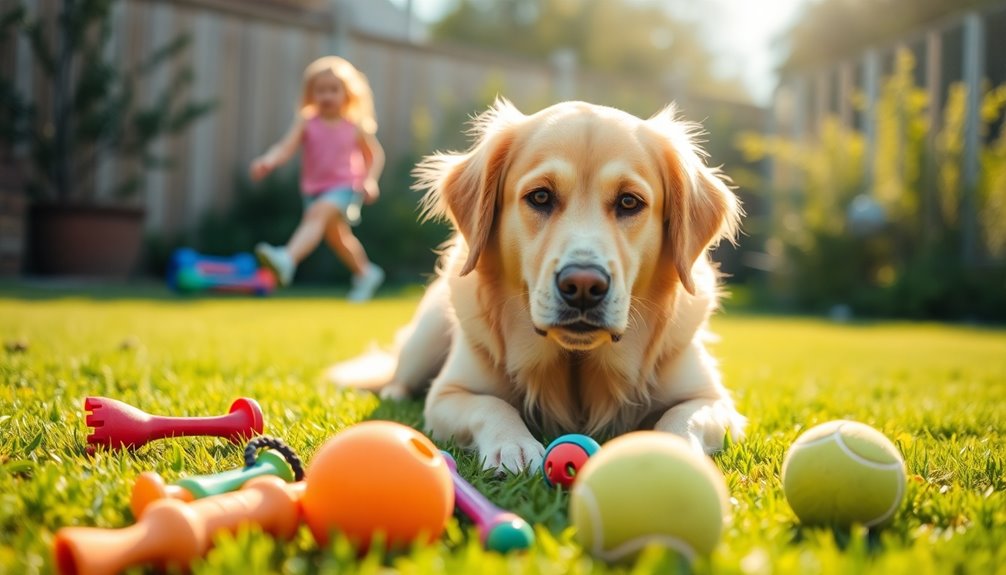
When it comes to your dog's well-being, just regular walks often aren't enough. If you notice your pup running in circles or jumping on furniture, they might be signaling a need for more physical and mental stimulation. Excess energy can lead to hyperactive behavior, which is a clear sign that your dog needs additional engagement.
Pay attention to increased vocalization, like barking or whining, especially during quiet moments. This restlessness usually indicates that your dog craves more activity.
Destructive behaviors, such as chewing furniture or excessive digging, can also stem from boredom. If your dog's eating habits suddenly change—whether overeating or losing interest in food—this could be linked to insufficient exercise and mental stimulation.
Lastly, look out for signs of anxiety, like pacing or clinginess. These behaviors often mean your dog requires more than just walks to feel secure and engaged in their environment. Additionally, providing regular health checks for your dog can help identify underlying issues that may contribute to their restlessness.
Importance of Mental Stimulation
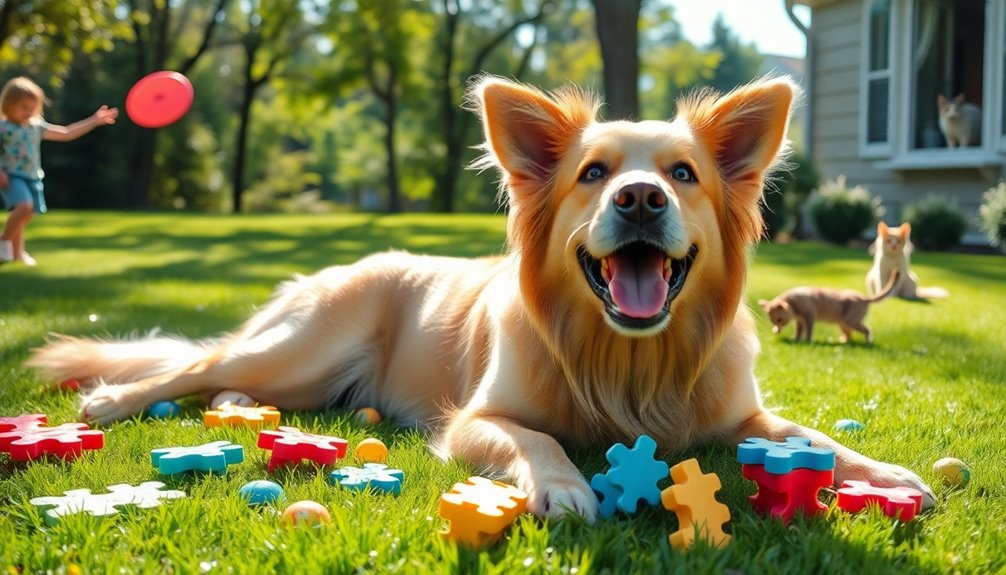
Simply taking your dog for a walk isn't enough to keep them happy and healthy. Dogs thrive on mental stimulation just as much as they do on physical exercise. Boredom can lead to destructive behaviors like chewing furniture or excessive barking, which can be avoided with engaging activities.
Mental challenges, such as puzzle toys or scent work, can greatly lower your dog's stress and anxiety levels, promoting their emotional well-being. Studies show that mental exercise can be as tiring for dogs as physical exercise can do wonders for their energy levels.
Interactive play, like fetch or hide-and-seek, not only strengthens your bond but also provides essential cognitive challenges. Regularly incorporating these activities into your routine contributes to better obedience and training responses, enhancing your dog's overall behavioral development.
Physical Exercise Beyond Walking
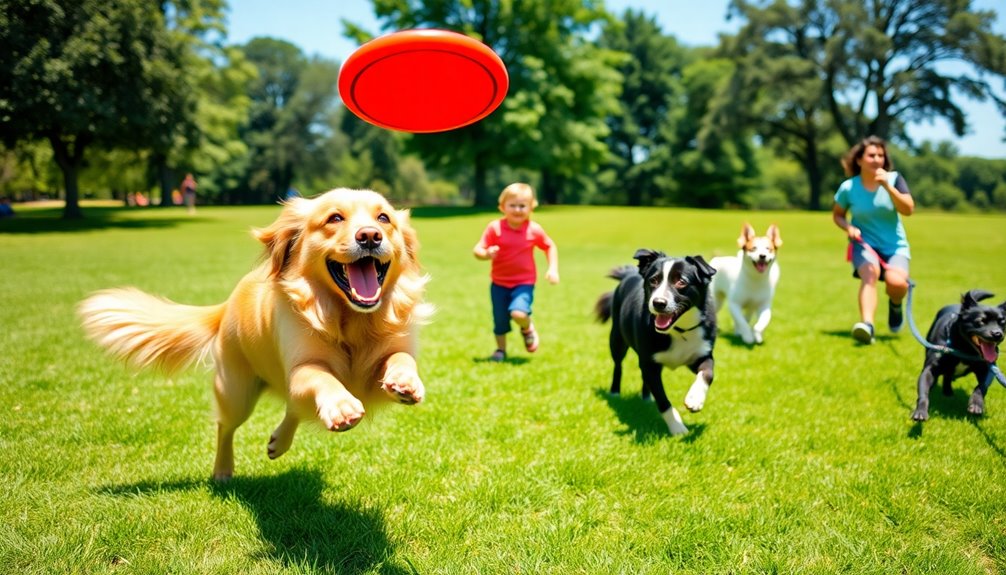
Most dogs need more than just regular walks to keep their bodies and minds in top shape. While daily walks are essential, incorporating other forms of physical exercise is important for your dog's overall happiness. Activities like running, swimming, or playing fetch can help expend their energy and maintain muscle tone.
Engaging in agility training or obedience classes not only provides physical exercise but also challenges your dog mentally. This can enhance their problem-solving skills and reinforce good behavior.
Interactive play sessions, such as tug-of-war or hide-and-seek, stimulate both physical and mental engagement, helping to mitigate boredom and reduce destructive behaviors.
Consider participating in dog sports, like flyball or dock diving, which offer structured, vigorous exercise while fostering socialization with other dogs and owners.
Additionally, incorporating varied terrains and environments, like hiking or visiting dog parks, can provide new challenges and sensory experiences essential for your dog's overall well-being.
Engaging Activities for Dogs
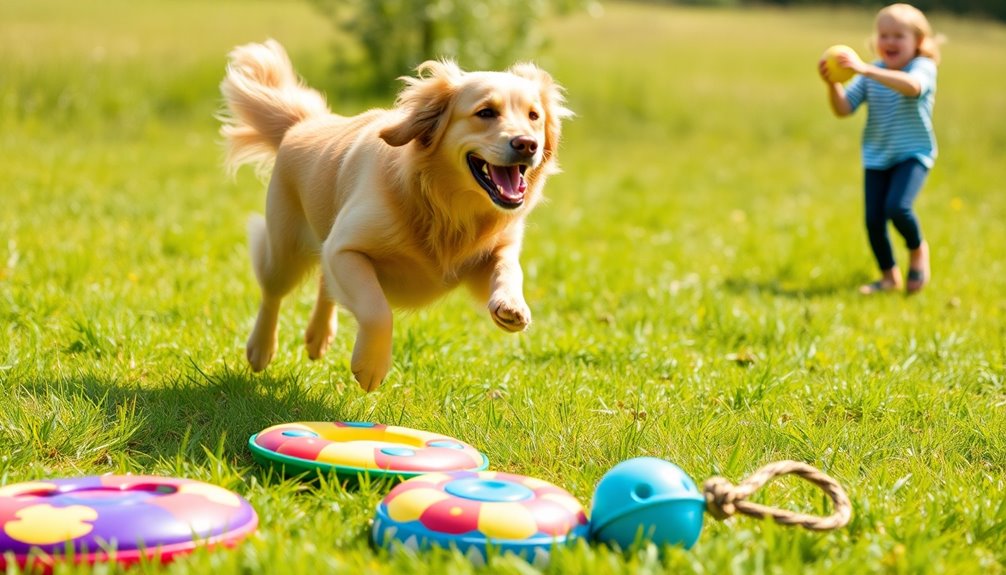
To keep your dog mentally stimulated, consider incorporating interactive play sessions that challenge their problem-solving skills.
Sniffing adventures can also tap into their natural instincts, creating a fun way for them to explore their surroundings.
Additionally, agility training options not only provide exercise but also build focus and confidence in your furry friend. Engaging in activities like therapy and assistance roles can further enhance your dog's well-being and strengthen your bond.
Interactive Play Sessions
Interactive play sessions are essential for your dog's well-being, offering both physical exercise and mental stimulation. Engaging in activities like fetch or tug-of-war helps burn off excess energy, reducing the risk of destructive behaviors.
When you incorporate puzzle toys or treat-dispensing games, you challenge your dog's cognitive abilities, promoting problem-solving skills and keeping their mind sharp.
Consider adding agility training or obstacle courses to your routine. These activities not only improve your dog's physical fitness but also strengthen the bond you share through teamwork and shared experiences.
Regular interactive play can greatly alleviate anxiety and stress, providing an outlet for pent-up energy, which is critical for their overall emotional well-being.
To keep things exciting, vary the play activities you introduce. This prevents boredom, ensuring your dog remains engaged and happy.
A well-rounded play routine is fundamental for maintaining good behavior and supporting your dog's mental health. By prioritizing interactive play sessions, you contribute positively to your dog's life, helping them thrive both physically and mentally.
Sniffing Adventures
Engaging your dog in sniffing adventures is a fantastic way to complement the interactive play sessions you've already established. These sniffing activities, often called "sniffaris," stimulate your dog's natural instincts and provide essential mental engagement. When you allow your dog to explore different scents during walks, you enhance their cognitive function and enrich their sensory experience.
Here are some fun sniffing activities you can try:
| Activity | Description |
|---|---|
| Treat Hide and Seek | Hide treats around your yard or home and let your dog find them. |
| Scent Trails | Create a trail using a specific scent and let your dog follow it. |
| Object Identification | Use different objects and encourage your dog to identify them by smell. |
| Nature Walks | Explore new areas where your dog can sniff out various natural scents. |
Incorporating these sniffing adventures into your daily routine can lead to positive behavioral changes. Not only do they promote relaxation and emotional well-being, but they also help alleviate anxiety and boredom. With increased mental stimulation, you may notice improved obedience and reduced aggression in your furry friend. Additionally, it's important to ensure that any treats used during these activities are safe, as some foods, like grapes for dogs, can be toxic and harmful.
Agility Training Options
Many dog owners underestimate the benefits of agility training, which offers a dynamic way to enhance your dog's physical and mental well-being.
By maneuvering through obstacles like tunnels, jumps, and weave poles, your dog gets a fantastic workout that improves coordination and balance. This engaging activity not only provides essential mental stimulation but also allows you to bond through teamwork and shared challenges.
Joining agility classes or competitions can also help your dog socialize with other pets and people, reducing anxiety and boosting confidence in various environments. Additionally, engaging in agility training can help mitigate behavioral issues that stem from excess energy or anxiety.
With regular practice, you'll notice your dog burning off excess energy, leading to a more balanced temperament and less likelihood of destructive behaviors.
Many local dog training centers and clubs offer agility courses tailored to different skill levels. These structured options can guide you both through the basics and beyond.
Plus, agility training can be a fun way for you and your dog to enjoy quality time together while developing communication and trust.
Socialization and Its Benefits

Socialization is essential for your dog's well-being, and regular walks provide the perfect opportunity to achieve this. When you take your dog for walks, they're exposed to diverse environments, sounds, and smells, helping them build confidence and reducing fearfulness in new situations. This exposure is vital for creating a happy dog that can adapt to various circumstances.
Interacting with other dogs during these walks fosters positive social skills, decreasing the likelihood of aggression and promoting better behavior around pets. The more your dog socializes, the more secure they'll feel, leading to improved emotional stability and overall happiness.
Engaging with friendly neighbors also strengthens community bonds, providing additional socialization benefits for both you and your dog.
Consistent socialization through walks enhances your dog's manners in public settings, making outings more enjoyable for both of you. You'll find that a well-socialized dog is easier to manage, allowing you to enjoy your time together without stress.
Recognizing Behavioral Changes
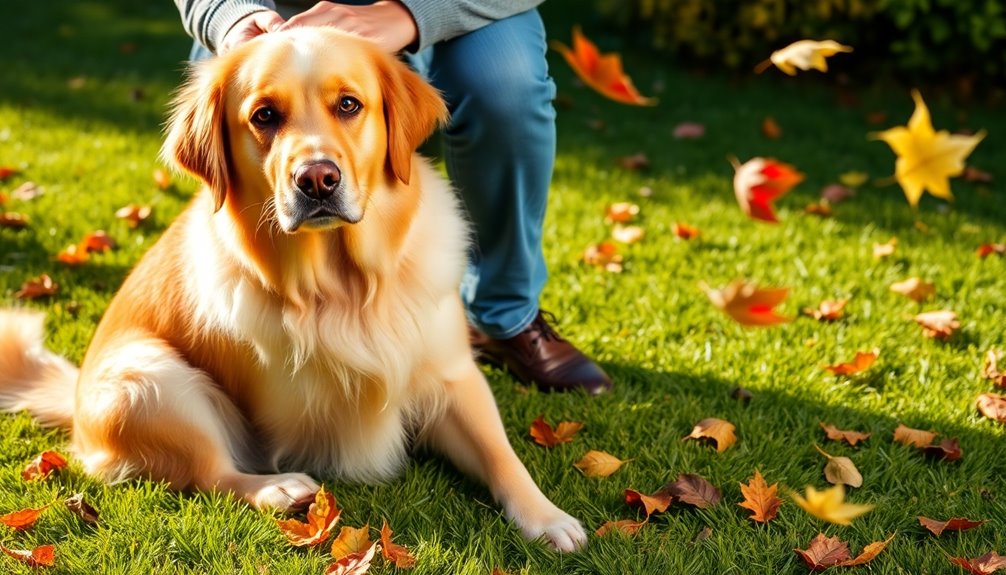
Over time, you may notice subtle changes in your dog's behavior that signal they're not getting enough exercise or mental stimulation. These behavioral changes can affect their overall mental health and well-being. It's crucial to stay observant and recognize when your dog might need more interaction.
| Behavioral Change | Possible Cause |
|---|---|
| Increased aggression | Lack of physical activity |
| Sudden withdrawal | Insufficient stimulation |
| Destructive behaviors | Boredom and need for engagement |
| Changes in eating habits | Lack of mental and physical exercise |
| Increased clinginess | Need for more interaction |
If you notice your dog becoming agitated or anxious, it might be due to pent-up frustration from inadequate exercise. A sudden withdrawal or listlessness can indicate they're not feeling engaged. Destructive behaviors like chewing furniture often stem from boredom, while changes in eating habits could be a sign of emotional distress. Increased clinginess may suggest your dog is seeking more attention and activities. By recognizing these signs, you can help improve your dog's mental health and overall happiness.
Professional Help and Resources
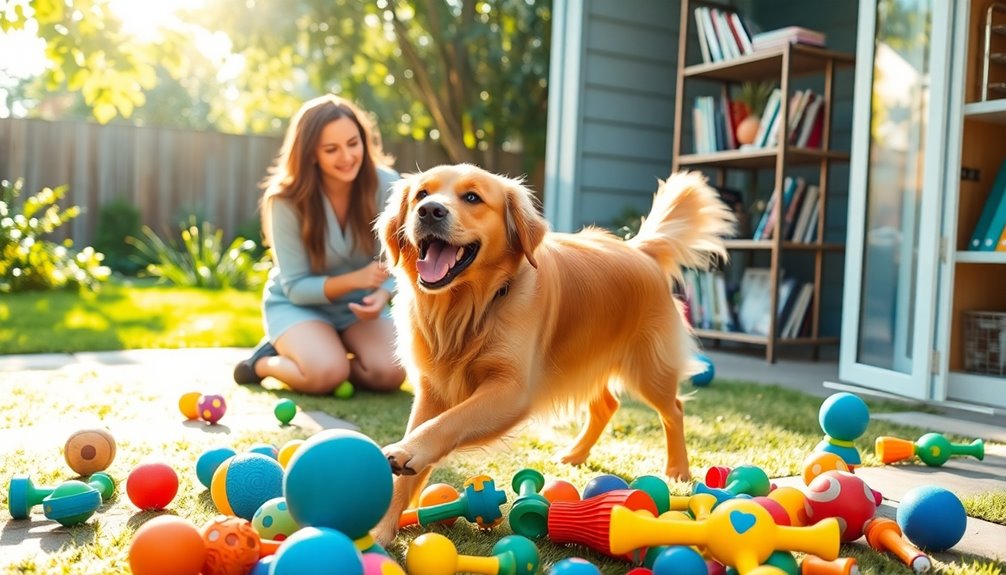
If you're noticing signs that your dog needs more than just walks, seeking professional help can make a significant difference. Consulting a veterinarian is a great first step, as they can provide tailored exercise plans that address your dog's specific health and weight management needs.
If your schedule's tight, hiring a dog walker guarantees your dog gets regular walks and the exercise they need, even when you can't be there.
Enrolling in local dog training classes can also be beneficial. These classes promote structured physical and mental engagement, enhancing obedience and social skills while providing necessary exercise.
Additionally, utilizing doggy daycare services offers socialization opportunities and physical activity, especially when you're away for extended periods.
If your dog exhibits behavioral issues related to their exercise needs, seeking professional trainers can be vital. They can help address pent-up energy and promote positive behaviors, leading to a happier, healthier dog. Furthermore, understanding your dog's exercise needs is crucial in ensuring they remain both physically and mentally stimulated.
Creating a Balanced Routine
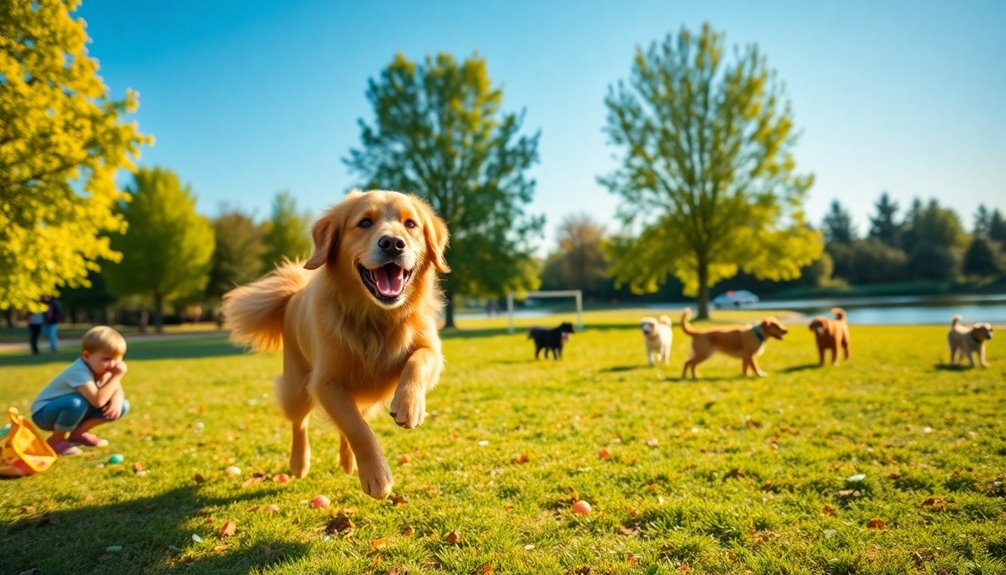
To create a balanced routine for your dog, you need to incorporate playtime sessions, schedule sniffing adventures, and engage in training activities.
Each element serves a purpose, ensuring your dog stays physically active and mentally stimulated.
Incorporate Playtime Sessions
Incorporating regular playtime sessions into your dog's daily routine can make a world of difference in their overall well-being. Engaging in interactive activities like fetch or tug-of-war for at least 20-30 minutes each day provides crucial mental stimulation and helps burn off excess energy. This not only complements the physical benefits of walks but also greatly reduces destructive behaviors linked to boredom.
Utilizing puzzle toys during playtime encourages cognitive engagement, allowing your dog to flex their problem-solving skills. This enhances their mental health and keeps their minds sharp.
Regular playtime also fosters a stronger bond between you and your dog, contributing to their happiness and emotional well-being. By providing varied outlets for energy, you create a more balanced routine.
Scheduled play sessions can help establish predictability, making your dog feel secure and reducing anxiety. This predictability can lead to improved behavior and a more contented pet. Additionally, incorporating dog quotes into your daily routine can offer inspiration and humor, enriching your experience with your furry friend.
Schedule Sniffing Adventures
Scheduling sniffing adventures can add a delightful dimension to your dog's routine, tapping into their natural instincts and providing essential mental stimulation. By designating specific times for these "sniffari" sessions, you enable your dog to explore their environment at their own pace. This not only enhances their cognitive function but also promotes relaxation and reduces anxiety during walks.
Consider the following ideas for incorporating sniffing adventures into your routine:
| Time of Day | Location | Activity |
|---|---|---|
| Morning | Local park | Free sniffing session |
| Afternoon | Neighborhood block | Scavenger hunt with treats |
| Evening | Garden or backyard | Explore different scents |
| Weekend | Nature trail | Long sniffing hike |
| Anytime | New areas in town | Discovery of unique smells |
Allowing your dog to engage in these sniffing adventures not only extends the duration of exercise but also makes it more enjoyable. This mental engagement fosters a stronger bond between you and your dog, creating shared experiences that lead to a more fulfilling life for both of you. Additionally, regular grooming can help manage excess fur that may accumulate during these outdoor explorations.
Engage in Training Activities
Regularly engaging in training activities can greatly enhance your dog's overall well-being and behavior. Incorporating obedience lessons or agility exercises not only provides essential physical activity but also offers crucial mental stimulation. This combination helps alleviate boredom and can markedly reduce destructive behaviors.
Regular training sessions sharpen your dog's focus and obedience, reinforcing good habits while strengthening the bond between you both. As you introduce new skills or tricks, you challenge your dog's cognitive abilities, leading to improved problem-solving skills and increased confidence.
Tailoring training activities to your dog's individual needs guarantees both energetic and less active dogs receive appropriate mental engagement. Establishing consistent training routines creates structure and predictability in your dog's daily life, which can reduce anxiety and promote a calm demeanor.
You'll find that your dog becomes more attentive and enthusiastic to please, making training a rewarding experience for both of you. So, don't just rely on walks—make training activities a regular part of your routine. Your dog will thrive on the mental challenges, and you'll enjoy the enhanced companionship that comes from an engaged and well-behaved pet.
Enhancing Your Dog's Well-Being
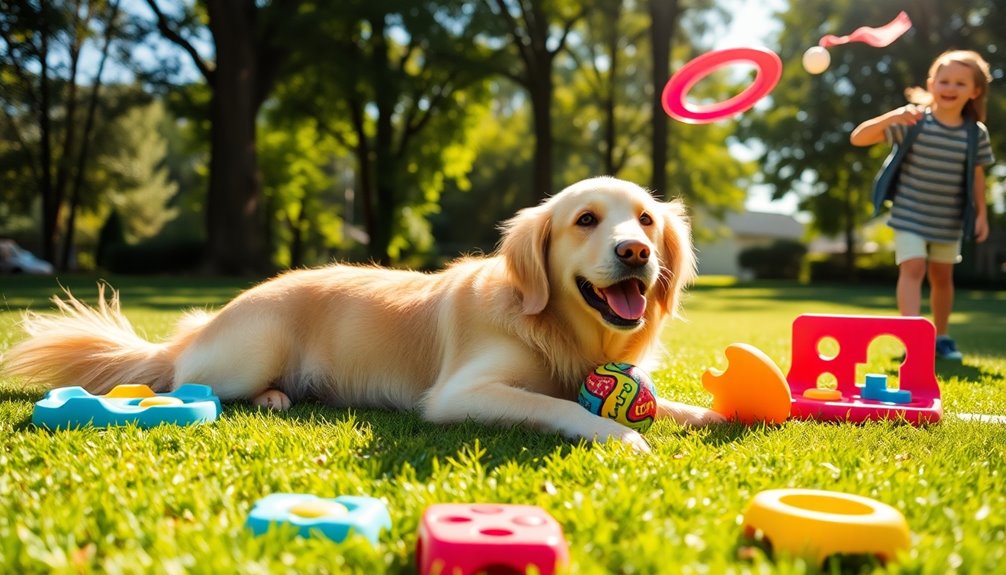
Enhancing your dog's well-being goes far beyond just taking them for daily walks. While dog walking is essential for physical exercise, it doesn't provide the mental stimulation your dog craves. To promote cognitive development, incorporate activities like puzzle toys and interactive games into their routine. These challenges keep their minds sharp and prevent boredom.
Consider engaging your dog in scent work or "sniffari" activities. This taps into their natural instincts and offers crucial mental enrichment that walking alone can't achieve.
Additionally, social playdates with other dogs can enhance their social skills and reduce anxiety, fostering confidence and a sense of community.
Don't forget about training sessions! Incorporating these into your daily activities not only strengthens obedience but also provides mental challenges, helping lower stress and improve behavioral responses.
Activities like agility training or obedience classes stimulate both physical and mental health, ensuring a well-rounded lifestyle.
Frequently Asked Questions
Is It Okay Not to Walk Your Dog Every Day?
It's not ideal to skip daily walks for your dog. Regular walks provide essential physical exercise and help maintain a healthy weight.
Without them, your dog might experience pent-up energy, leading to destructive behavior or anxiety.
Additionally, daily walks offer social interaction and mental stimulation, which are vital for their overall well-being.
If you can't walk them every day, consider alternative activities like playdates or interactive games to keep them engaged.
Why Does My Dog Want to Be Walked All the Time?
Imagine your dog's a child cooped up in a classroom—restless and craving adventure. That's how your dog feels when they want to be walked all the time.
Regular walks provide essential exercise and mental stimulation, helping to prevent boredom and anxiety. Each outing lets them socialize and explore, fulfilling their natural instincts.
If they're enthusiastic for walks, it's a sign they need that physical and mental engagement to thrive and stay happy.
Do I Need to Walk My Dog Everyday if I Have a Yard?
Yes, you should walk your dog every day, even if you have a yard.
While a yard offers some space to play, it can't replace the varied experiences and social interactions found on walks. Daily walks expose your dog to new sights, sounds, and smells, engaging their instincts and preventing boredom.
They also provide essential exercise and help regulate your dog's digestive system, strengthening your bond through shared adventures.
Is 2 Walks a Day Enough for a Dog?
Two walks a day might be enough for some dogs, but it really depends on their individual needs.
If your dog's an active breed or has high energy, they probably need more than just walks to stay happy and healthy.
Consider adding playtime, mental challenges, or socialization opportunities to their routine.
Assess their age, breed, and energy levels to determine if two walks are sufficient for your pup's well-being.
Conclusion
Just like a garden needs more than sunlight to thrive, your dog craves more than just walks. By nurturing their mind and spirit through play, socialization, and varied activities, you cultivate a deeper bond and a happier pup. Think of each engagement as a drop of water, helping your canine companion flourish. Remember, a fulfilled dog is a joyful one, so let your efforts bloom into a vibrant life together, filled with wagging tails and playful barks.


